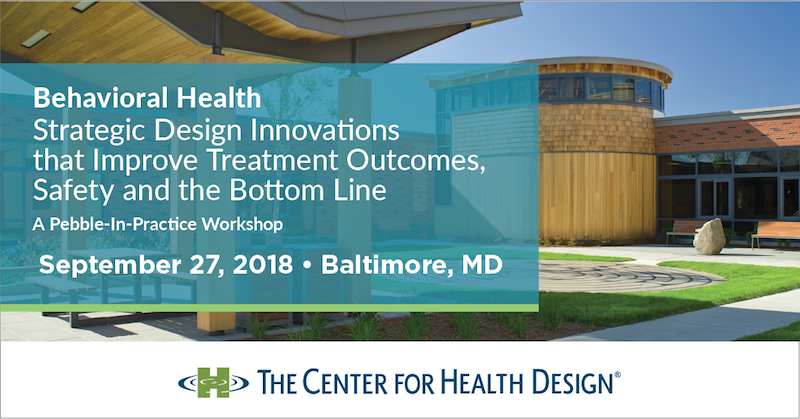$495

Consider the needs of behavioral health patients in every healthcare space you design...
 The challenges created by today’s growing mental health and substance abuse crises reach far beyond the behavioral health unit into emergency departments, outpatient clinics and throughout acute care settings.
The challenges created by today’s growing mental health and substance abuse crises reach far beyond the behavioral health unit into emergency departments, outpatient clinics and throughout acute care settings.
To support improved care and enhance staff safety, today’s design, facility and care professionals have to advance their understanding of design’s impact on behavioral health care and learn how to incorporate the best and latest design solutions throughout the healthcare setting.
Back by popular demand, this one day interactive, collaborative, problem-solving workshop is intended to enable design professionals to employ physical design strategies and methodologies that support improved care for behavioral health. Join us and engage with a faculty of experts in behavioral health and design to set the stage for the path forward.
Hyatt Regency Baltimore Inner Harbor
300 Light Street
Baltimore, MD 21202
United States
Rooms available: Wednesday, September 26 - Thursday, September 27, 2018
Click here to book your room: https://book.passkey.com/go/eea23b06
Hear the industry's leading behavioral health facility design experts share how design is making a difference in the lives of children and adults faced with behavioral and mental health conditions. They’ll share real world experiences and future-looking insights into:
Existing standards and behavioral health models
Strategies that address behavioral health across various population groups
Design methodologies that hinder or enhance behavioral health
Case studies of state-of-the art facilities that support behavioral health.
This unique experience is ideal for individuals who are intending to design new mental and behavioral health facilities and those
wishing to evaluate the quality of their existing facilities.

Samira Pasha, PhD, AIA, EDAC, LEED BD+C, Lean Six Sigma Green Belt, Architect & Researcher, Cumming Construction Management Group
Opening Keynote: Design for Mental and Behavioral Health
Throughout centuries, many different aspects of society had to evolve to create today's model of care for members of the society who are diagnosed with mental illness. Through the lens of design and architecture, the presentation gives an overview of this transformation.

Kimberly Newton McMurray, AIA, EDAC, MBA, Principal, Behavioral Health Facility Consulting, LLC
How & Why Behavioral Health Inpatient Unit Design is Different from Medical/Surgical Unit
In this session we will explore the differences in the basic functions of patient rooms in behavioral health inpatient units and inpatient rooms in medical/surgical hospitals. We will examine how the design of these healing environment needs to be completely different.
Then we will delve into the current state of research and leading thinking regarding the design of behavioral health patient environments and review some of the current collaboration between designers, product manufacturers and hospitals that is making new, innovative products and solutions possible.
We will conclude by reviewing the three-year process of the Institute for Patient-Centered Design from its national design competition for a behavioral health patient room and bathroom through the construction of a high-fidelity mock-up of the winning design at the Veterans Administration Hospital in Lyons, New Jersey earlier this year. Research is currently underway to analyze this installation.
Jim Hunt and Brian Giebink will present with Kimberly.

Jim M. Hunt, AIA, President, Behavioral Health Facility Consulting, LLC
How & Why Behavioral Health Inpatient Unit Design is Different from Medical/Surgical Unit

Brian Giebink, AIA, LEED AP, Project Architect, HDR
How & Why Behavioral Health Inpatient Unit Design is Different from Medical/Surgical Unit

Dennis C. Robert, AIA, Principal | Studio Director, Array Architects
Safe Emergency Departments through Innovative Design, Technologies and Staffing Considerations
In this session we will explore the impacts architects, planners and interior designers can have on the behavioral health epidemic. While, as designers, we have little control over funding and other socio-economic factors that contribute to the crisis, but what we do have is the ability to increase efficiency for the caregivers with our designs and the ability to positively enhance the patients experience. We will assess the current state of behavioral health in the United States and look to what the future holds. Analysis of case studies will be presented to address both the current state and design approach, but also to consider forward thinking progressive design responses for this underserved area. The initiation of care, often in the emergency department, is a very important aspect of access to care. This session will present ways in which the design community can collectively contribute to the urgent need.

Kayvan Madani-Nejad, PhD, AIA, Senior Healthcare Architect, U.S. Department of Veterans Affairs, Facilities Standards Service
The Future of Integrated Outpatient Mental Healthcare Delivery: A New Paradigm for Outpatient Clinic Design
The cost impact of untreated behavioral health issues surpasses the top five medical illnesses combined in terms of our GDP. For veterans, the incidence of mental illness is even greater, and with 20 years of conflict, the numbers and severity of mental illness will continue to increase. The development of efficient, economical outpatient care models and the facilities to support them are vital. The Veterans Administration has developed some of the most progressive clinic designs utilized for care. Their PAC model, based on a collaborative core, is now being adapted to incorporate and accommodate mental healthcare into the model, truly providing whole-person care.
Gary M. Fischer will present with Kayvan.

The Future of Integrated Outpatient Mental Healthcare Delivery: A New Paradigm for Outpatient Clinic Design

Jennifer Edmonds, MLIS, EDAC, Market Intelligence Analyst, ERDMAN
IP, OP, and ED Integration of Behavioral Health Care: The Bulle Rock Project
STUDIO E, an ERDMAN Center of Thought Leadership & Innovation in Healthcare, is working with several behavioral health clients on the hypothesis, “Can concepts driving culture change in senior living and other aspects of healthcare – such as small household design and on-stage/off-stage planning – translate in a behavioral healthcare setting to facilitate an effective balance between safety and patient comfort, dignity, and control?” Related to this hypothesis is the thought: Can architecture influence behavior? We believe the answer is yes, by having a human-scaled environment of care. In support of the ongoing work around this hypothesis, Jennifer will share case studies and work on the boards of a variety of projects embracing this approach.

Shary Adams, AIA, ACHA, EDAC, LEED AP BD+C, Principal, SmithGroup
Behavioral Health Behind Closed Doors
MedStar Health is using fast-track design to help catalyze a new model of behavioral health, using the reduction of barriers, small house concepts and interior design strategies to create positive environments where patients are positively impacted. Renovations to the existing system facilities include:
Inpatient Units: Expanded units for both voluntary and involuntary patients, as well as an inpatient detoxification units.
ED Crisis Units: Crisis intervention units designed for maximum patient and staff safety with compassionate and timely clinical care.
Day Programs: Partial hospitalization programs (PHP), as well as intensive outpatient programs (IOP) for patients are critical components.
OP Services: A complete range including psychotherapy and counseling; individual and group therapy; psychiatric evaluation and chronic disease management; integrated transitional services with the partial hospitalization program; community outreach program offerings; substance use disorder counseling and rehabilitation.
Jill Johnson and Kevin Haggerty will present with Shary.
Behavioral Health Behind Closed Doors

Behavioral Health Behind Closed Doors

Jerry Sheward, MD, Chief Medical Officer, Indiana Family Social Services Administration
State of the Art: A Holistic Approach to Behavioral Health Treatment Facilities
The Neuro-Diagnostic Institute and Advanced Treatment Center is Indiana’s first new state mental hospital since 1952. First of its kind, this facility will diagnosis and develop treatment plans for all ages with a wide range of brain-related illnesses. The facility, scheduled to begin serving patients in early 2019, will be a key component allowing Indiana to be equipped to diagnose and care for those who suffer from neurological and mental health disorders. The design utilizes the existing Community East infrastructure to form a new facility and a connector between the two buildings, with a variety of new systems and state-of-the-art equipment.

Francis Murdock Pitts, Founding Partner and President, architecture+
Closing Keynote: What’s Next for Design for Behavioral Health?
Mr. Pitts will use his own firm’s groundbreaking work and will reflect upon the presentations made by colleagues during this Pebble-in-Practice Workshop to pose and answer a number of important questions about the current state and future possibilities for care environments for the mentally ill.